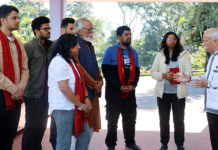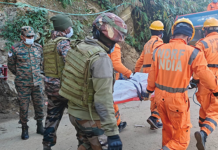[ Tayi Taggu ]
It is a timeless knowledge that great civilisations anywhere in the world developed on riverbanks, and Pasighat is fortunate as lady luck smiles on her. She is nestled in the eastern Himalayas, at 155 metres (509 ft) above mean sea level, on the right bank of the mighty Siang river. Almighty Donyi Polo is beaming with a smile, hinting to Pasighatians that their talisman and star favour them, which radiates energy to shine, signalling that Pasighat is on the path to becoming Arunachal Pradesh’ most thriving city for generations to come.
Pasighat has unparalleled growth opportunities and limitless scope in education, medical health, sports, agriculture, allied sectors, industry, etc. However, any development work comes with problems and challenges which are no less daunting, but the oldest town in the state is preparing itself for a better tomorrow, shedding its old skin, rejuvenating and reincarnating itself for the next big lift. After a long lull and many lost decades, Pasighat is not only marching ahead but is ready to fly and its wings were added by the government of India, which found it fit to include it in the Smart Cities Mission development in June 2017, which is a real blessing and proved to be a great game changer. After decades of stagnation, Pasighat is soaring ahead, boosted by its inclusion in the Smart Cities Mission in June 2017 – a transformative milestone.
The basic requirement for any civilisation is water,which supports agriculture and ecosystems. The Siang river, Pasighat’s lifeline, has long supported life and offers world-class rafting opportunities, positioning the region as a hub for adventure water sports. Meanwhile, the Pasighat Smart City Development Corporation Ltd (PSCDCL) has made significant strides, completing 33 of 43 projects with the rest set for completion by March 2025. Meeting this deadline remains a major challenge, pushing agencies and contractors to comply with the ministry’s directives is a tough call.
Pasighat’s growth potential is vast, with its location serving as a gateway to various districts and headquarters. Excellent medical facilities, esteemed educational institutions, and seamless connectivity via air, land, and waterways make it an attractive destination. Pasighatians may feel that change is slow and time-warped, yet it is no exaggeration that the smart city projects rapidly transform Pasighat into a modern and vibrant city. Anyone who saw Pasighat two or three years ago and returns today would be amazed at the sea of difference and the rapid phases of development taking place. None of the newly-built structures existed three years ago. The iconic four-lane concrete smart road from Siang Sadan (DC’s residence) to the district civil secretariat (DC’s office) via the smart guestgouse and the Siang guesthouse is the only four-lane concrete road in the state.
The Market Upgradation Iconic Buildings (Phases I & II) and the open theatre in the heart of the city have enhanced its aesthetic appeal far beyond what Pasighatians could have imagined three years ago. The recreation centre now boasts a swimming pool, three badminton courts, a skating ground, a gym, children’s playrooms, table tennis, billiards, a children’s park, and a restaurant, adding to its charm. The riverfront features more than 2 kms of road exclusively for amusement, and morning and evening walks, offering a space for people to enjoy the refreshing Siang river breeze, surrounded by breathtaking views of the hills and the river’s galloping current. The smart car parking facility at Bakin Pertin General Hospital introduces a modern parking system with the latest technology. Meanwhile, the integrated command and control centre serves as the nerve centre of the smart city, monitoring 198 cameras across 36 locations, detecting theft cases, and providing live surveillance of road accidents to ensure swift assistance to victims. The Centurion Park near the Siang guesthouse has become a breathing space for the city, featuring a walking path, round seating for social gatherings, an open gym for exercise and yoga, and a rejuvenation pond that directly taps fresh water from a natural fountain – an exemplary groundwater recharge initiative.
The district library & children’s e-learning centre now provides separate reading rooms to encourage reading habit among students. Two mini-football stadiums, one at Daying Ering Higher Secondary School and another near Independent Golden Jubilee Higher Secondary School, aim to promote student participation in sports and nurture future stars for the state and the nation. Besides, a big stadium of 10,000capacity already exists, and a fourth one is proposed as a cricket stadium.
The rehabilitation centre in Jarkong seeks to reintegrate drug addicts – who pose a serious social challenge – back into the mainstream. The sewage treatment plant and solid waste management plant at Jarkong aim to curb the growing plastic and waste menace in the city. Several smart roads have also been developed to facilitate smoother vehicular movement.
A modern auditorium has been built for the Independent Golden Jubilee Govt Higher Secondary School, and the new Vivekananda Kendra School near the North Eastern Institute of Ayurveda and Folk Medicine stand out as valuable additions to the city’s educational infrastructure. These are just a few of the major projects undertaken by the Pasighat Smart City Development Corporation Ltd, while several smaller projects continue to be executed.
Upon completion, the smart guesthouse is set to become the finest in the state, featuring four presidential suites, four executive suites, 32 deluxe rooms, three seminar halls, and separate dining halls for VIPs and general guests, comparable to top-rated star hotels. The lingering question on many minds is how Pasighat will become the most important city in the coming decades. The answer is clear: its strategic location is at the heart of Arunachal Pradesh. Serving as a vital gateway, Pasighat connects to many districts and headquarters, all reachable within one-and-a-half to three hours, with only a few exceptions. All the district headquarters of eastern Arunachal are accessible from Pasighat within five hours, and it boasts the best medical facilities in the state after Itanagar.
Pasighat has carved out a niche as a future city, with a location that offers immense potential for growth as a financial and educational hub. It is also a centre for agriculture, horticulture, palm oil, and industries, with vast land available to support a growing population. Furthermore, it is considered to be the rice bowl of the state.
If all goes according to plan, a resurgent Pasighat will become the most connected city in the state, with access through air, railway, land, and inland waterways – proposals for which are already in the pipeline. Pasighat also serves as a key air travel hub for travellers from Tuting, Anini, Aalo, Mechukha, Roing, Tezu, Itanagar, and Guwahati, as it functions as a refuelling depot for civil aviation in the eastern sector of Arunachal.
Pasighat has earned many laurels to her credit. Officially founded in 1911 by the British, it became the first administrative headquarters established in the North East Frontier Tract (NEFT). TE Furze, an Imperial Police officer, was the first assistant political officer posted in Pasighat in 1912, as per records. The first airfield was established in 1946, when Pasighat was also known as Paglek, followed by the establishment of the first agricultural institute in 1950 and the first hospital in 1954.
Jawaharlal Nehru College, the first college in the North East Frontier Agency (NEFA), was established on 3 July, 1964, becoming the torchbearer of education in the state. In the first three decades after Arunachal became a union territory and later a state, many prominent leaders and bureaucrats were alumni of JNC. Another landmark moment came in 1966, when the first All India Radio (AIR) station in NEFA was established in Pasighat, broadcasting in Adi language, a proud milestone for the region.
Today, Pasighat boasts three universities – the Arunachal Pradesh University, the Rashtriya Raksha University, and the Apex Professional University -along with eight colleges in the belief that the destiny of a nation is shaped in its classrooms. JNC, the oldest, has the largest student enrollment in the region, with 4,200 students per academic session. The College of Horticulture and Forestry holds the number two rank in India, and due to its outstanding performance, the NITI Aayog has recognised it as a knowledge partner in the country. Other institutions include the College of Agriculture, Polytechnic College, College of Nursing, and the North Eastern Institute of Ayurveda and Folk Medicine, alongside three private colleges – Doying Gumin, Siang Royal, and Daying Ering. A proposed medical college is also set to be established soon, further strengthening Pasighat’s claim as a medical hub of Arunachal.
Pasighat was once on the verge of becoming the state capital, as high officials of the NEFA strongly advocated shifting the administrative headquarters from Shillong to Pasighat. The high official vision was to enhance governance by developing better roads, education, and healthcare infrastructure within NEFA. Pasighat was favoured due to its vast plains, which provided an ideal setting for a new state capital.
However, opportunities are often fleeting, like lady luck, whose favour is easily swayed. To the dismay of many Adis, a small but influential group opposed the proposal, launching a campaign against the establishment of the capital in Pasighat. Their resistance was enough to deter the decision-makers, and with a heavy heart, the officials abandoned their plan. The debate over who was right or wrong continues to divide the Adi society, yet the only takeaway is that history offers lessons for the future.
Pasighat is well connected to Assam via NH 515, and the Bogibeel bridge has been a game-changer for north Assam and eastern Arunachal. The 227-km Murkongselek-Pasighat-Tezu-Rupai railway line, currently under construction, is being undertaken as a strategic defence project. Additionally, Pasighat plays a crucial logistical role in major hydropower projects, with 500+ 16-wheel trucks expected to transport construction materials daily for the 2,880 mw Lower Dibang Valley dam. The proposed 11,000 mw Siang river dam will require even more staggering thousand-plus trucks per day, positioning Pasighat as the economic and financial hub of Arunachal for the coming decades and beyond.
Pasighat is also home to the Daying Ering Wildlife Sanctuary, one of the state’s most renowned wildlife parks. The sanctuary hosts Indian elephants, wild pigs, sambhar, and barking deer, along with the Bengal florican, a critically endangered bird with fewer than 2,000 individuals left worldwide. This rare species can be spotted in March, April, and May. Furthermore, Pasighat houses the headquarters of the Adi Baane Kebang and the Central Donyi Polo Yelam Kebang, which serve as the de facto cultural parliament overseeing the cultural, linguistic, traditional, and religious aspects of the Adi people.
Victor Hugo said, “Nothing is more powerful than an idea whose time has come.” The idea of a thriving and harmonious Pasighat is no longer a distant dream. Overcoming its historical errors, Pasighat has traversed a beautiful journey of development and prosperity, where every effort has been made to make the life of Pasighatians meaningful, and the journey has begun. (The contributor is Deputy Commissioner, East Siang district).




